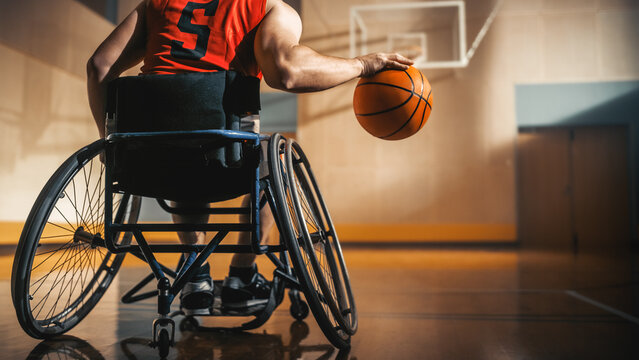Wheelchair basketball is a fast-paced and dynamic sport played by athletes with physical disabilities that impair their mobility. It is played on a standard basketball court with some modifications to accommodate the use of wheelchairs. The objective of the game is similar to traditional basketball, where two teams compete to score points by shooting a ball through an elevated hoop.
The sport has its roots dating back to the late 1940s when it was initially introduced as a form of recreational therapy for World War II veterans with spinal cord injuries. Over the years, wheelchair basketball has evolved into a highly competitive and organized sport, with international governing bodies and professional leagues.
In wheelchair basketball, players use specialized wheelchairs designed for maneuverability, stability, and durability during the game. These wheelchairs are typically made of lightweight materials like aluminum or titanium and feature features such as angled footrests, wing-style hand rims, and anti-tip casters for improved control and agility.
The rules of wheelchair basketball are similar to those of traditional basketball, with a few adaptations to accommodate the use of wheelchairs. Players must dribble or pass the ball while propelling their wheelchairs with their hands. Certain rules govern wheelchair movements, such as the prohibition of lifting or raising the wheels from the court surface while in possession of the ball.
Wheelchair basketball is an inclusive sport that welcomes athletes with various disabilities, including spinal cord injuries, amputations, and other mobility impairments. It promotes physical fitness, teamwork, and personal growth while challenging societal perceptions and breaking down barriers for individuals with disabilities.
Table of Contents
Importance of Specialized Wheelchairs
Wheelchair basketball is a highly competitive and physically demanding sport, requiring specialized equipment designed specifically for the rigors of the game. Regular wheelchairs, while functional for everyday use, are not suitable for the intense movements, speed, and impacts involved in wheelchair basketball.
Specialized wheelchairs for basketball are engineered to provide players with superior maneuverability, stability, and durability on the court. These chairs are lower to the ground, allowing players to have a better center of gravity and improved balance during rapid direction changes and collisions. The lightweight yet sturdy construction enables players to accelerate quickly and navigate the court with agility.
Furthermore, specialized wheelchairs for basketball feature advanced technologies and design elements that enhance performance and safety. Adjustable seating systems and customizable components allow players to optimize their positioning and biomechanics for better control and energy efficiency. Specialized wheels and tires are designed for superior traction and responsiveness, enabling players to execute sharp turns and sudden stops without compromising stability.
By using specialized wheelchairs tailored for the demands of wheelchair basketball, players can perform at their highest level while minimizing the risk of injuries or equipment failures. These specialized chairs not only level the playing field but also promote fair competition and showcase the incredible athleticism and skill of the players.
Materials Used in Wheelchair Basketball Construction
Wheelchair basketball chairs are designed to be lightweight yet durable, maneuverable, and able to withstand the rigors of the sport. The materials used in their construction play a crucial role in achieving these characteristics. Common materials include:
Aluminum Alloys: Aluminum alloys are widely used for the frame construction due to their high strength-to-weight ratio, corrosion resistance, and ease of fabrication. These alloys provide a sturdy yet lightweight structure, ensuring agility and responsiveness on the court.
Carbon Fiber: Carbon fiber is an advanced composite material renowned for its exceptional strength and stiffness while being incredibly lightweight. It is often used for the frame, wings, or footrests, enhancing the chair’s overall performance and maneuverability.
Titanium: Titanium, although more expensive, is sometimes used in high-end wheelchair basketball chairs due to its superior strength, lightweight nature, and corrosion resistance. It contributes to a durable yet agile design.
Stainless Steel: Certain components, such as axles, caster housings, or fasteners, may be made from stainless steel to provide strength, durability, and resistance to wear and tear.
Polyurethane: Polyurethane is a common material used for the seat and backrest upholstery. It offers a combination of comfort, breathability, and easy maintenance, ensuring a comfortable seating experience during intense gameplay.
High-Performance Plastics: Various high-performance plastics, such as nylon or polyethylene, are employed for components like caster wheels, footrests, or side guards. These materials offer durability, low friction, and resistance to impacts and abrasion.
The careful selection and combination of these materials ensure that wheelchair basketball chairs are optimized for speed, agility, and durability, while also considering factors like weight distribution, stability, and player comfort.
Frame Design and Construction
The frame is the backbone of a wheelchair basketball chair, designed to provide optimal stability, maneuverability, and weight distribution for the athlete. These specialized frames are typically constructed from lightweight yet durable materials such as aluminum, titanium, or carbon fiber.
The frame structure is meticulously engineered to strike a balance between rigidity and flexibility. A rigid frame ensures stability during rapid movements and collisions, while strategic flex points allow for enhanced maneuverability and agility on the court.
Weight distribution is a crucial factor in wheelchair basketball frame design. The frame is strategically designed to distribute the athlete’s weight evenly, lowering the center of gravity for improved stability and control during sharp turns and sudden stops.
Additionally, the frame geometry plays a significant role in the chair’s maneuverability. Carefully calculated angles and dimensions facilitate smooth pivoting, turning, and quick directional changes, enabling athletes to navigate the court with precision and speed.
To further enhance stability and control, many wheelchair basketball frames incorporate an anti-tip system, typically consisting of rear-mounted caster wheels or outriggers. These features help prevent backward tipping during aggressive movements or collisions, providing an added layer of safety for the athlete.
Wheel and Tire Specifications
Wheel and tire specifications play a crucial role in enhancing the performance and maneuverability of wheelchair basketball chairs. These specialized chairs require wheels that can withstand the rigors of the sport while providing optimal traction and responsiveness.
Wheel size is a critical consideration in wheelchair basketball. Typically, the wheels range from 24 to 26 inches in diameter, with 25-inch wheels being the most common choice. Larger wheels offer increased speed and momentum, while smaller wheels provide better maneuverability and quicker turning.
The materials used in wheelchair basketball wheels are designed for durability and performance. High-strength aluminum alloys or carbon fiber composites are commonly used for the wheel rims, offering a lightweight yet robust construction. These materials also resist deformation and ensure consistent performance over time.
Tire selection is equally important in wheelchair basketball. Pneumatic tires, filled with air, are the preferred choice for their ability to absorb shocks and provide excellent traction on various court surfaces. These tires are typically made of high-quality rubber compounds that offer a balance between grip and low rolling resistance.
Tread patterns on wheelchair basketball tires are engineered to optimize grip and handling. Aggressive tread designs with deep grooves and siping (small slits in the tread) enhance traction during sudden stops, starts, and directional changes. However, excessive tread depth can increase rolling resistance, so a balance must be struck between traction and efficiency.
Proper tire inflation is crucial for optimal performance and safety. Underinflated tires can lead to increased rolling resistance, reduced speed, and potential stability issues. Overinflation, on the other hand, can compromise traction and shock absorption. Manufacturers typically provide recommended inflation pressures based on the specific tire and user weight, ensuring optimal performance and longevity.
Seating and Positioning Systems
Proper seating and positioning are crucial for wheelchair basketball players to maintain stability, comfort, and optimal performance during the game. The seating system in a wheelchair basketball chair is designed to keep the player securely in place while allowing for mobility and maneuverability.
The seat itself is typically made of a durable, breathable material that provides cushioning and support. It is contoured to fit the player’s body shape and distribute weight evenly, reducing the risk of pressure sores and discomfort. Many seats feature adjustable tension or air cushions to accommodate individual preferences and needs.
Back support is another essential component of the seating system. A sturdy backrest, often with a rigid frame or reinforced panel, helps maintain proper posture and spinal alignment. Some backrests are adjustable, allowing players to fine-tune the angle and height for maximum comfort and support during gameplay.
Strapping systems are also incorporated into wheelchair basketball chairs to ensure the player stays securely in place during sudden movements or collisions. These straps, typically made of durable materials like nylon or polyester, are adjustable and padded for comfort. They may include lap belts, shoulder harnesses, or other restraints to keep the player firmly positioned in the chair.
Adjustment mechanisms are a key feature of wheelchair basketball seating systems, allowing for customization to each player’s unique body type and preferences. These mechanisms may include levers, knobs, or buttons that enable adjustments to the seat height, depth, tilt, and recline angles. This level of adjustability ensures optimal positioning, comfort, and performance for each individual player.
Overall, the seating and positioning systems in wheelchair basketball chairs are designed to provide a secure, comfortable, and customizable experience for players, allowing them to focus on their game without worrying about stability or discomfort.
Safety Features and Regulations
One of the most crucial aspects of wheelchair basketball is ensuring the safety of players. These specialized wheelchairs are designed with several safety features to minimize the risk of injuries during intense gameplay. Crash protection is a key consideration, with reinforced frames and strategically placed bumpers to absorb impacts from collisions. Additionally, these wheelchairs often incorporate sturdy footplates and wheel guards to protect the player’s extremities.
Braking systems are another essential safety component. High-performance disc brakes or drum brakes are commonly used, providing reliable and responsive braking power to prevent collisions and maintain control during sudden stops or directional changes. These brakes are designed to withstand the rigors of fast-paced gameplay while ensuring the player’s safety.
Wheelchair basketball is governed by strict safety standards and regulations set forth by organizations like the International Wheelchair Basketball Federation (IWBF) and national governing bodies. These standards cover various aspects, including wheelchair specifications, court dimensions, and gameplay rules. For instance, there are specific requirements for the overall dimensions, weight, and stability of the wheelchairs to ensure fair play and prevent any unfair advantages.
In addition to the physical aspects of the wheelchairs, the rules of wheelchair basketball emphasize safety. Regulations govern player conduct, contact, and foul play to minimize the risk of injuries. Strict enforcement of these rules by officials helps maintain a safe and fair playing environment for all participants.
Customization and Personalization
Wheelchair basketball players often require customized chairs to accommodate their specific needs and preferences. Adjustments can be made to the seat height, depth, and angle, as well as the footrest position and backrest recline. These modifications ensure proper posture, balance, and comfort during gameplay.
Another important aspect of customization is the ability to incorporate team colors and personal flair. Players can choose from a range of frame colors, upholstery options, and even add decals or graphics to represent their team or individual style. This not only enhances the overall aesthetic appeal but also fosters a sense of team unity and individual expression.
Furthermore, various accessories can be added to the wheelchair to improve performance or convenience. These may include additional strapping systems for enhanced stability, cup holders for hydration, or even specialized storage compartments for personal items. By tailoring the wheelchair to their unique requirements, players can optimize their mobility, comfort, and overall gaming experience.
Maintenance and Care
Proper maintenance and care are crucial for ensuring the longevity and optimal performance of your wheelchair basketball chair. Regular cleaning, proper storage, timely repairs, and understanding the expected lifespan can help you get the most out of your specialized equipment.
Cleaning: Wheelchair basketball chairs are subjected to intense use and can accumulate sweat, dirt, and debris. It’s essential to clean your chair regularly to maintain its appearance and prevent the buildup of bacteria or odors. Use a mild soap and water solution to wipe down the frame, wheels, and upholstery. Avoid harsh chemicals or abrasive cleaners that could damage the materials.
Storage: When not in use, store your wheelchair basketball chair in a dry, cool place, away from direct sunlight and moisture. Prolonged exposure to extreme temperatures or humidity can cause damage to the frame, wheels, and upholstery. If storing for an extended period, consider covering the chair or using a storage bag to protect it from dust and debris.
Repairs: Regular inspections and prompt repairs are essential for maintaining the safety and performance of your wheelchair basketball chair. Check for loose bolts, worn tires, or any signs of damage to the frame or components. It’s recommended to have your chair serviced by a qualified technician or the manufacturer’s authorized repair center to ensure proper maintenance and the use of genuine replacement parts.
Lifespan: The lifespan of a wheelchair basketball chair can vary depending on the quality of materials, frequency of use, and level of care. High-quality chairs made with durable materials and designed for intensive use can last several years with proper maintenance. However, even the best chairs will eventually need to be replaced due to wear and tear or obsolescence. Regularly inspecting your chair and addressing any issues promptly can help extend its lifespan and ensure your safety on the court.
Future Developments and Innovations
Wheelchair basketball is an ever-evolving sport, and manufacturers are constantly exploring new technologies, materials, and designs to enhance performance and user experience. One emerging trend is the integration of advanced composite materials, such as carbon fiber and kevlar, into the frame construction. These lightweight yet incredibly strong materials can significantly reduce the overall weight of the wheelchair while maintaining structural integrity, resulting in improved maneuverability and acceleration.
Another area of innovation is the incorporation of 3D printing technology in the manufacturing process. 3D printing allows for highly customized and personalized designs, enabling athletes to have wheelchairs tailored to their specific body dimensions and playing styles. This level of customization can optimize comfort, ergonomics, and performance, giving players a competitive edge on the court.
In addition, researchers are exploring the use of smart materials and embedded sensors to monitor various aspects of the wheelchair and the athlete’s performance. These technologies could provide real-time data on factors such as wheel alignment, tire pressure, and even biometric indicators like heart rate and fatigue levels. This information could be invaluable for coaches and trainers in optimizing training regimens and making informed decisions during gameplay.
Furthermore, advancements in battery technology and electric propulsion systems may pave the way for electric-assist or hybrid wheelchair designs. These innovative designs could help players conserve energy during gameplay, potentially extending their playing time and reducing fatigue-related injuries.
As the sport continues to grow in popularity, manufacturers and researchers are likely to explore even more cutting-edge solutions to enhance the overall experience of wheelchair basketball players. From aerodynamic designs to advanced materials and intelligent systems, the future of wheelchair basketball promises to be an exciting and innovative journey.



